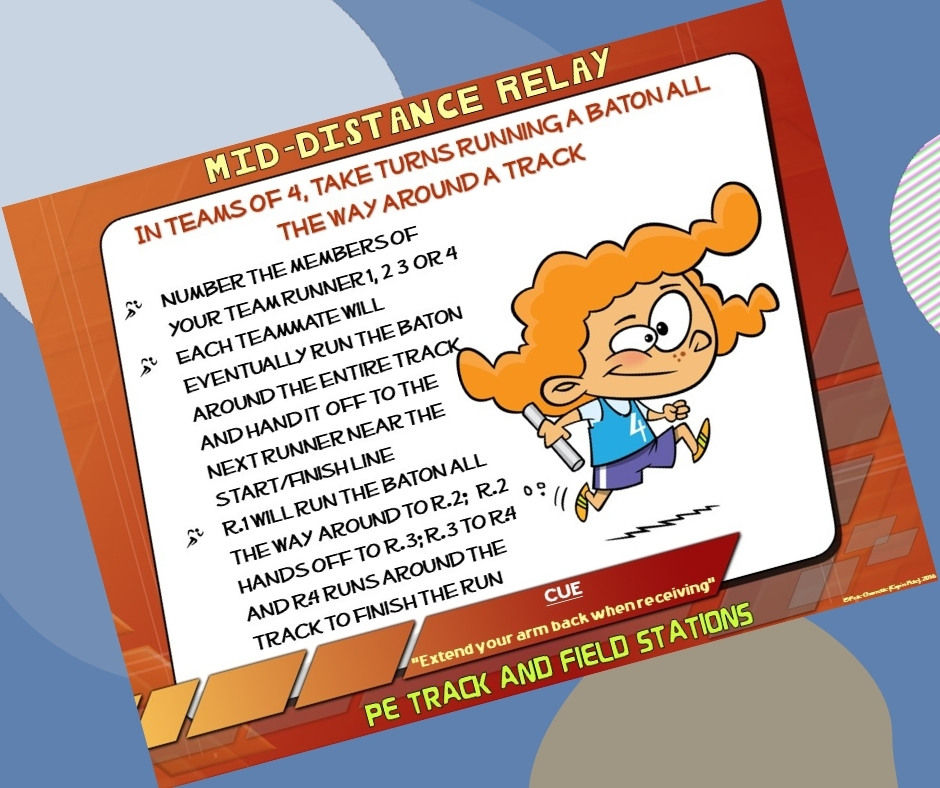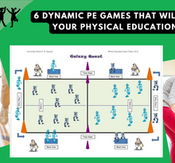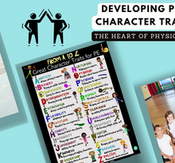Physical education is an essential part of a student's academic journey. It plays a crucial role in developing physical, mental, and social health. The inclusion of track and field activities in a physical education program is an excellent way to help students develop these skills. Introducing track and field track and field lessons into your physical education curriculum offers an outstanding opportunity for students to be active and involved in their learning. The activities can include running, jumping, and throwing, and can be incorporated into physical education classes in a variety of ways. Moreover, you can easily modify a lesson plan to suit different age groups or skills levels.

This article will dive into the advantages of including track and field skills in physical education programs, as well as present several useful tips for successful implementation. Additionally, I will provide you with ten energetic and engaging track and field skill activity ideas that work well with all ages, including kindergartners all the way to high school seniors!
Quick Section Links
Click any of the links below to jump to a section of this article:
Benefits of Implementing Track and Field Skills into PE Classes
Implementing track and field skills into a physical education program can offer numerous benefits for students of all ages and abilities. Some of the key benefits include:
Physical Fitness: Track and field stations are excellent for building cardiovascular fitness, strength, power, and endurance. Running, jumping, and throwing are all high-intensity exercises that can improve overall fitness levels.

Pic by MLE PE @MLE_PE
Motor Skills Development: Track and field activities require a combination of fine and gross motor skills. Running involves coordination between the arms and legs, while jumping and throwing require precise movements of the hands and feet. Regular participation in track and field activities can help students develop their motor skills.
Coordination: Track and field stations require coordination between different parts of the body, such as the arms, legs, and core. Regular participation in these activities can improve overall coordination and body control.
Social Skills Development: Many track and field activities, such as relay races, require teamwork and collaboration. These activities can help students develop social skills and learn how to work together towards a common goal.
Self-Esteem: Participating in track and field events can help to boost a student's self-esteem as they develop a sense of accomplishment and build confidence in their abilities. This can have a positive impact on their overall mental health and well-being.
Video by recreACTION worthington (Rob Smith) @theworthington2
Healthy Competition: Track and field activities can provide a healthy competitive environment for students to compete against each other in a safe and supportive environment. If you deliver high quality track activities, it can help students learn how to compete in a fair and respectful manner and develop a sense of sportsmanship.
Stress Relief: Engaging in physical activity, such as track and field, can help reduce stress and anxiety in students. It can also help improve their overall mood and mental health.

Lifelong Habits: Incorporating track and field stations into a physical education program can help promote healthy habits and a love for physical activity. As students develop their skills and improve their fitness, they may be more likely to continue participating in physical activity outside of school.
Can track and field activities in PE help students meet standards?
Absolutely! Track and field stations can help students meet physical education standards. The national PE standards includes objectives related to physical fitness, motor skills development, and social and emotional learning. A quality track and field unit, at any level, can address many of these objectives, making them it valuable addition to a PE curriculum.
This blog post's featured physical education track and field activities/stations are directly linked to Shape America's Standard 1: Develops a variety of motor skills. The track and field activities you choose to implement during your PE lessons can easily meet any national, state, or district standards.
Tips for implementing track and field activities in PE Lessons
Here are some practical tips for implementing track and field activities into a physical education program:
Video and pics by Megan Lessert @LessertMegan
1 - Start with the basics: Begin with simple activities, such as relay races or standing long jumps, to ensure that all students can participate and feel successful. As students gain confidence and skill, more advanced activities can be introduced.
2 - Provide proper equipment: To ensure safe and effective participation in track and field activities, it's important to provide students with age and skill-appropriate equipment. This may include pool noodles, hula hoops, playground balls, a school track, etc.
3 - Create a safe environment: When teaching track and field activities, it's important to create a safe environment for students. This includes providing adequate warm ups, and making sure the area is free from obstacles and hazards, providing appropriate supervision, and demonstrating and enforcing safe practices.

Pic by Randi-Lee Hauptman @MrsHauptman4
4 - Tailor activities to individual needs: Consider the needs and abilities of all students when planning activities. Modify activities or provide alternative options for students who may have physical or cognitive limitations.
5 - Make it fun: Incorporate fun challenges, such as obstacle courses or relay races with a twist, to keep students engaged and motivated. Consider using music or colorful equipment to make the activities more appealing and exciting.
6 - Encourage teamwork: Many track and field activities, such as relays, require teamwork and collaboration. Encourage students to work together and support one another, and consider incorporating team-building activities into the curriculum.

Pic by Randi-Lee Hauptman @MrsHauptman4
7 - Incorporate variety: To keep students engaged and interested, incorporate a variety of different track and field activities. Mix things up by incorporating relay races, long jump, high jump, shot put, and other activities.
By implementing these tips, teachers can create a safe, inclusive, and engaging track and field program that meets the needs of all students.
10 Track and Field Activity Stations for Physical Education
Looking for some fun and engaging track and field activity stations to implement into your physical education lesson plans? Here are ten exciting ideas:
1: Javelin (Pool Noodle) Throw
Overview - Students throw a pool noodle (using a javelin throw style) out to the open field, as far as possible, and then measure their results.
Student Instructions
Throw a tetherball (using a hammer throw circle style) out to the open field as far as possible
Don't go past the “throw line” before you release the rope and ball
Have a partner mark your distance with a polyspot
Measure the distance with a measuring tape or by using premarked lines
2: Running Long Jump
Overview - Students run fast, then take off from one foot and jump (1 foot to 2 feet) as far as they can into a pit or on to a mat and then measure results.
Student Instructions
Run as fast as possible to the jump line, and take off from one foot
Jump far and land on both feet into a pit or on to a soft mat
Have a partner mark your distance with a polyspot or beanbag
Measure the distance with a measuring tape
Video by recreACTION worthington (Rob Smith) @theworthington2
3: Short Distance Sprints
Overview - Students run short sprints (40 m to 200 m) from a start line to the finish line while they time themselves or race against others within their ability level.
Student Instructions
After the start “signal”, run a fast sprint starting from a crouch position and running past the finish line
Have someone time you (with a stopwatch) or race against others with your same ability
Take turns being the sprinter and a starter
4: Discus (Flying Disc) Throw
Overview -Students throw a Frisbee (using a discus style) out to the open field, as far as possible, and then measure their results.
Student Instructions
Throw a Frisbee (discus style) out to the open field as far as possible
Don't go past the “throw line” before you release the Frisbee
Have a partner mark your distance with a polyspot
Measure the distance with a measuring tape or by using premarked lines
5: Hurdle (Short Distance) Sprint
Overview - Students run short distance sprints, leaping over hurdles in their straight line path.
Student Instructions
After the “start signal”, run a fast sprint and leap (1 foot to the other) over the hurdles that are in your path
Have someone time you (with a stopwatch) or race (side-by-side) against others with your same ability
Sprint fast past the finish line
6: Shotput (Softball) Throw
Overview - Students throw a softball (using a shotput style) out to the open field, as far as possible, and then measure their results.
Student Instructions
Throw a softball (using a shotput style) out to the open field as far as possible
Don't go past the “throw line” before you release the softball
Have a partner mark your distance with a polyspot
Measure the distance with a measuring tape or by using premarked lines
7: Middle Distance Relay
Overview - Students run mid-distance races, leaping over hurdles set around an oval marked track.
Teacher Instructions
Number the members of your team Runner 1, 2 3 or 4
Each teammate will eventually run the baton around the entire track and hand it off to the next runner near the start/finish line
R.1 will run the baton all the way around to R.2; R.2 hands off to R.3; R.3 to R.4 and R.4 runs around the track to finish the run
8: Hammer (Tetherball) Throw
Overview - Students throw a tetherball (using a hammer throw circle style) out to the open field, as far as possible, and then measure their results.
Student Instructions
Throw a tetherball (using a hammer throw circle style) out to the open field as far as possible
Don't go past the “throw line” before you release the rope and ball
Have a partner mark your distance with a polyspot
Measure the distance with a measuring tape or by using premarked lines
9: Triple Jump
Overview - Students run fast to a hop line, and then 1. Hop on one foot, 2. Step to the opposite foot and then 3. Jump into a pit or soft mat landing on 2 feet.
Student Instructions
Run fast to the hop line, and then 1. hop on one foot, 2. step to the opposite foot and then 3. jump into a pit or on to a soft mat (landing on both feet)
Have a partner mark your distance with a polyspot or beanbag
Measure the distance with a measuring tape
10: Cross-Country Steeplechase
Overview - Students each run a set distance on a grass or dirt marked trail while jumping over hurdles set in their path.
Student Instructions
After the “start signal”, run around a “marked trail” a set number of times
Jump over any hurdles that are in your path
Pace yourself and don’t try to move too fast early in the run
Have someone time you (or race against others with your same ability
Final Thoughts
Incorporating track and field station activities into an elementary or middle school physical education program can have many benefits for students. It can help them develop physical fitness, motor skills, coordination, self-esteem, and teamwork skills. By following the tips outlined in this article, physical education teachers can implement track and field activities effectively and help their students reap these benefits.

Pic by Randi-Lee Hauptman @MrsHauptman4
With the right approach, track and field activities can be a fun, engaging way to promote physical activity and develop lifelong healthy habits. Whether it’s sprinting or hurdling around a marked track or throwing a discus (Frisbee) across the open field with friends – there is something above for everyone so don’t forget to give some of these activities a try during your next PE class!
Good luck with your Track and Field endeavors! 🏃 🙌 😃🎉 👍😊😁✨❤️☺️👌
Need resources?
Do you need some sport-related skill stations for your physical education program that includes detailed instructions and state-of-the-art graphics and visuals? Cap'n Pete's Power PE has you covered!

Fill in the form below to download 20 FREE Sport-Specific PE Station Signs. The set is a PDF digital download that includes two visuals (cards/signs) from the following sport stations sets: 1. Base Games, 2. Basketball, 3. Floor Hockey, 4. Football, 5. Lacrosse, 6. Paddle & Racket Sports, 7. Soccer, 8. Team Handball Stations, 9. Track & Field and 10. Volleyball Stations.
This freebie set will be sure to enhance your PE curriculum for years!
If you want even more track and field station ideas...my PE Track and Field Stations- 20 Run, Jump and Throw Zones resource can be downloaded here on Teachers Pay Teachers.
If you're searching for a way to really spice up your PE program, Cap'n Pete's PE Sports Stations- 10 Product Mega Bundle is the perfect supplement. You'll find over 200 fun-filled, sports-themed station signs/cards (20 stations per sport) in this set. You may utilize them in your gym or specialized learning area.
You can download them from either of the following platforms: Cap'n Pete's Power PE Website or Teachers Pay Teachers- Cap'n Pete's TPT Store
This comprehensive collection will help you teach your students important physical education concepts and skills from 10 different traditional sports including basketball, base games, football, floor hockey, lacrosse, paddle/racket sports, soccer, track & field, team handball, and volleyball.




























